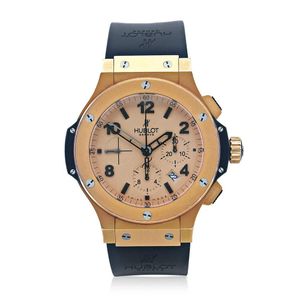Hublot Big Bang Pink Gold Automatic Chronograph Wristwatch
Hublot Big Bang ref 301PI500RX An 18ct pink gold and titanium automatic chronograph wristwatch with registers and date, circa 2008. Dial matte salmon dial, applied black Arabic numerals and faceted baton indexes, skeletonised hands, chronograph hand with. H counterweight, subsidiary dials for constant seconds, 30-minute and 12-hour registers, aperture for date. Calibre automatic winding movement, 27 jewels, pierced tungsten carbide rotor with black PVD-treated surface. Case brushed pink gold and titanium tonneau-form case and bezel secured by six screws, crown flanked by twin chronograph buttons, crystal display back secured by six screws. Case number 666245. Closure black Hublot rubber strap with an 18ct pink gold and black PVD steel Hublot folding clasp. Dimensions 44 mm diameter, bracelet circumference approximately 190 mm. Signed case, dial, and movement. Accessories Hublot warranty, swing tag, presentation box and outer box. Provenance: Important Jewels, Sotheby's Australia, 8 August 2018, lot 180, illustrated. Private Collection, Sydney, acquired from the above
You must be a subscriber, and be logged in to view price and dealer details.
Subscribe Now to view actual auction price for this item
When you subscribe, you have the option of setting the currency in which to display prices to $Au, $US, $NZ or Stg.
This item has been sold, and the description, image and price are for reference purposes only.
- Date Aperture - A date aperture is a cut out section in the face of a watch or clock, displaying the day of the month.
- Bezel - On a clock or watch, the bezel is the metal frame into which the watch or clock glass is fitted. In clocks, the bezel may include a hinge and a flange, in effect a door to the face of the clock. In jewellery the bezel is a band of metal with a projecting lip that holds the gemstone in its setting.
- Circa - A Latin term meaning 'about', often used in the antique trade to give an approximate date for the piece, usually considered to be five years on either side of the circa year. Thus, circa 1900 means the piece was made about 1900, probably between 1895 and 1905. The expression is sometimes abbreviated to c.1900.
- Chronograph - A chronograph is a watch that also incorporates the features of a stopwatch, to measure elapsed time. Most chronographs are operated by two buttons, one to start and stop the chronograph second hand, and the other to return that hand to the starting position.
- Baton Numerals - A watch that instead of displaying numerals on the face, displays a marker in the form of a baton, or lower case letter "L". Since the baton-like marks are not numerals, the feature is also called baton markers, baton indexes and baton indicators.
- Movement - The technical name for the workings of a clock or watch, and does not include the dial or case.
This item has been included into following indexes:
